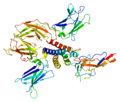IL-2 receptor
IL-2 receptor is a type of protein found on the surface of certain types of immune cells, including T lymphocytes. It binds to a substance called interleukin-2 (IL-2), which triggers these cells to divide and grow. Some forms of immunotherapy for cancer may work by blocking the action of IL-2, thereby preventing the growth of T cells and, in turn, slowing the growth of the cancer.
Structure[edit]
The IL-2 receptor is composed of three chains: alpha (CD25), beta (CD122), and gamma (CD132). The gamma chain is shared with other receptors such as IL-4, IL-7, IL-9, IL-15 and IL-21 receptors.
Function[edit]
The IL-2 receptor is involved in cell signaling and helps regulate the activities of white blood cells that are responsible for immunity. The receptor is present on the surface of the T cells, where it plays a crucial role in the activation and growth of T cells.
Clinical significance[edit]
Abnormalities in the IL-2 receptor have been associated with several autoimmune diseases, including rheumatoid arthritis, type 1 diabetes, and multiple sclerosis. In addition, elevated levels of soluble IL-2 receptor in the blood can be indicative of certain types of lymphoma.
Therapeutic use[edit]
Several drugs have been developed that target the IL-2 receptor, including basiliximab and daclizumab, which are used to prevent rejection in organ transplantation. These drugs work by blocking the action of IL-2 on its receptor, thereby suppressing the immune response.
See also[edit]
Ad. Transform your life with W8MD's Budget GLP-1 injections from $75


W8MD offers a medical weight loss program to lose weight in Philadelphia. Our physician-supervised medical weight loss provides:
- Weight loss injections in NYC (generic and brand names):
- Zepbound / Mounjaro, Wegovy / Ozempic, Saxenda
- Most insurances accepted or discounted self-pay rates. We will obtain insurance prior authorizations if needed.
- Generic GLP1 weight loss injections from $75 for the starting dose.
- Also offer prescription weight loss medications including Phentermine, Qsymia, Diethylpropion, Contrave etc.
NYC weight loss doctor appointmentsNYC weight loss doctor appointments
Start your NYC weight loss journey today at our NYC medical weight loss and Philadelphia medical weight loss clinics.
- Call 718-946-5500 to lose weight in NYC or for medical weight loss in Philadelphia 215-676-2334.
- Tags:NYC medical weight loss, Philadelphia lose weight Zepbound NYC, Budget GLP1 weight loss injections, Wegovy Philadelphia, Wegovy NYC, Philadelphia medical weight loss, Brookly weight loss and Wegovy NYC
|
WikiMD's Wellness Encyclopedia |
| Let Food Be Thy Medicine Medicine Thy Food - Hippocrates |
Medical Disclaimer: WikiMD is not a substitute for professional medical advice. The information on WikiMD is provided as an information resource only, may be incorrect, outdated or misleading, and is not to be used or relied on for any diagnostic or treatment purposes. Please consult your health care provider before making any healthcare decisions or for guidance about a specific medical condition. WikiMD expressly disclaims responsibility, and shall have no liability, for any damages, loss, injury, or liability whatsoever suffered as a result of your reliance on the information contained in this site. By visiting this site you agree to the foregoing terms and conditions, which may from time to time be changed or supplemented by WikiMD. If you do not agree to the foregoing terms and conditions, you should not enter or use this site. See full disclaimer.
Credits:Most images are courtesy of Wikimedia commons, and templates, categories Wikipedia, licensed under CC BY SA or similar.
Translate this page: - East Asian
中文,
日本,
한국어,
South Asian
हिन्दी,
தமிழ்,
తెలుగు,
Urdu,
ಕನ್ನಡ,
Southeast Asian
Indonesian,
Vietnamese,
Thai,
မြန်မာဘာသာ,
বাংলা
European
español,
Deutsch,
français,
Greek,
português do Brasil,
polski,
română,
русский,
Nederlands,
norsk,
svenska,
suomi,
Italian
Middle Eastern & African
عربى,
Turkish,
Persian,
Hebrew,
Afrikaans,
isiZulu,
Kiswahili,
Other
Bulgarian,
Hungarian,
Czech,
Swedish,
മലയാളം,
मराठी,
ਪੰਜਾਬੀ,
ગુજરાતી,
Portuguese,
Ukrainian





